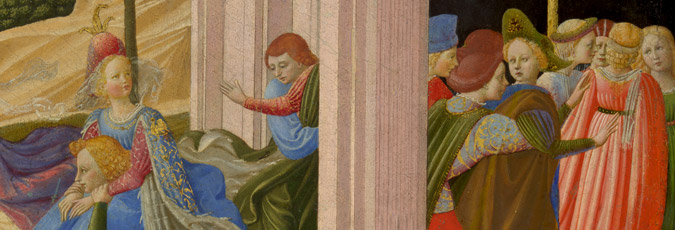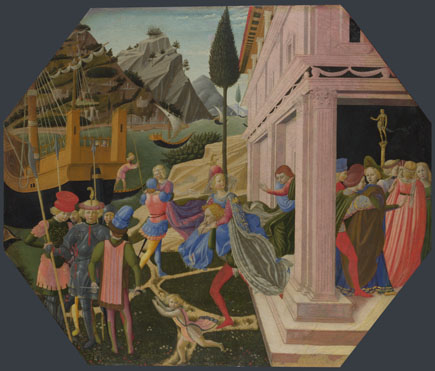Zanobi Strozzi (1412–68)
'The Abduction of Helen', about 1450–5
Egg tempera on poplar, irregular octagon, painted surface 51.0 x 60.8 cm
NG591
This 'desco da parto' (or birth tray), was originally twelve-sided and slightly larger, but it was cut down (especially at the top) at the same time as new pieces of wood were added to the corners to make up its present octagonal shape.1 This has particularly affected the crowning elements of the pink building, which has lost part of its jutting corner and right-hand tabernacle window, together with some of the upper cornice and the colonnettes supporting wooden eaves.
The subject derives from Homer’s ‘Iliad’ and depicts the moment when the Trojan Prince Paris abducts Helen, the wife of Menelaus, King of Sparta – a fateful action which led directly to the Trojan Wars, although its epic significance is not the focus of this painting. The source is likely to be Dares Phrygius’s ‘De Excidio Troiae Historia’, which tells Homer’s story from a Trojan point of view and helps to explain why this painting interprets the abduction in a rather positive light. Dares’s text also moves the scene from Menelaus’s palace on mainland Sparta to the island of Cythera, where Helen had gone to worship in the Temple of Diana and Apollo. The painter exploits the visual delights of an island setting, with its flowery meadows, boats bobbing on the surrounding sea, and views of other mountainous Greek islands, as well as seizing the opportunity to design a building that takes up more than a third of the picture.
Serial abductions
The abduction itself seems swift and surprising, but playful, rather than violent or fear-inspiring. It is not only Helen who is being abducted but at least three other women (a fourth is being targeted by the blonde man in a high blue hat just to the right of the corner pier), enabling Zanobi Strozzi to show physical interaction between men and women. Helen rides on the shoulders of her abductor, another woman is being lifted off the ground in an ‘embrace’, and another inside the building is being grabbed from behind. This tallies with the passage in the text stating: ‘they stormed the temple and carried Helen off to their ships – she was not unwilling – along with some other women they had taken’.2
This kidnapping might seem an inappropriate subject for a birth tray intended to promote a happy marriage, reproduction and family values (including piety), but Homer and his medieval and Renaissance imitators stressed that this was the moment when Paris and Helen fell in love. It may therefore seem strange that Paris, who is most probably the figure in armour looking out of the picture in the left foreground, is removed from Helen, and displays himself to the viewer instead. Again, Strozzi may have taken his clue from Dares, who says that he was ‘confident of his own good looks, and began to walk within sight of Helen’.3
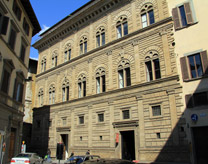
Although the building in this picture is supposedly the Temple of Diana and Apollo on the island of Cythera, the only feature identifying it as a temple is the statue of a deity on a column, displayed against a black interior.4 In other respects its design is emphatically that of an Italian Renaissance palace, apparently imitating Alberti’s design for Palazzo Rucellai in Florence, built in the mid-1450s, with its façades articulated by a superimposed order of Corinthian pilasters and a loggia ('altana') under the roof supported by colonettes (fig. 1). It is an architecturally precocious design for the 1450s. No new palaces included tabernacle windows and doors with triangular pediments at this date. Zanobi Strozzi may have taken these from the Baptistery façade, or similar windows such as those seen in Ghiberti’s ‘Meeting of Solomon and Sheba’ and ‘Story of Joseph’ from the Gates of Paradise of about 1452, or Masaccio’s depiction of two palaces in the 'Raising of the Son of Theophilus' in the Brancacci Chapel (1424–7).5
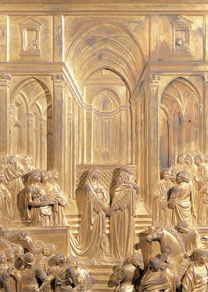
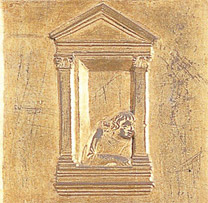
The fluted Corinthian pilaster nearest the viewer is of the type adopted by Brunelleschi at San Lorenzo (begun in the 1420s), and the unity of this temple/palace design partly depends on the consistent use of Corinthian capitals on all three storeys.6
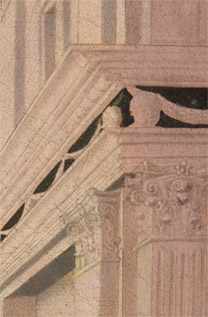
The framing techniques are particularly subtle, with layers of receding planes stepped back towards the deep interior. Strozzi’s architectural depiction is not dependent on line here, for he uses very delicate shading to create fine gradations in depth and to convey a sense of mass, but in a light rather than a heavy way. These refinements, together with the pink colour and the frieze with festoons and putti all help to make this building prettier and more decorative than any Florentine palace of the 1450s.
Davies 1961, pp. 33–4; Gordon 2003, pp. 426–32.
This material was published in April 2014 to coincide with the National Gallery exhibition 'Building the Picture: Architecture in Italian Renaissance Painting.'
To cite this essay we suggest using
Amanda Lillie, ‘Zanobi Strozzi, The Abduction of Helen’ published online 2014, in 'Building the Picture: Architecture in Italian Renaissance Painting', The National Gallery, London, http://www.nationalgallery.org.uk/research/research-resources/exhibition-catalogues/building-the-picture/entering-the-picture/strozzi-abduction-of-helen

